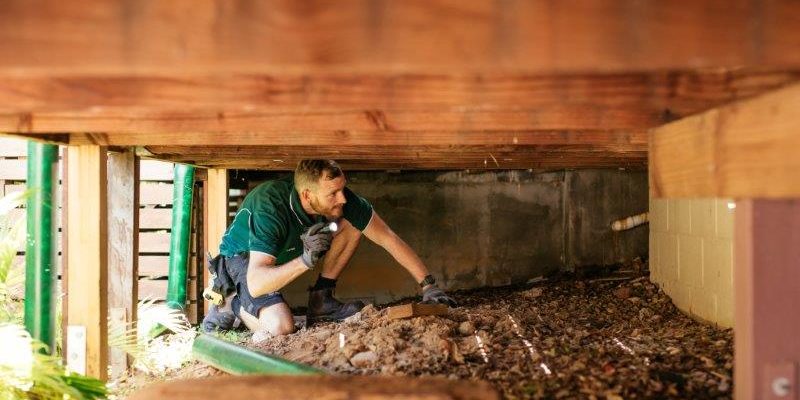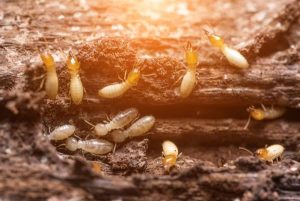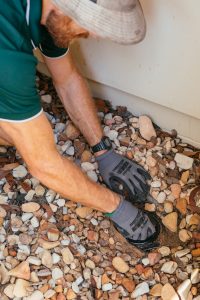How Do Termites Get Into Your Home?
- June 3, 2019
- in Pest Control
- by Rod Greer
- 195
- 0

Termites are considered the most destructive and invasive insects in the world and they are causing worldwide damage worth of billions of dollars each year. If left uncontrolled, they can cause a lot of havoc. So you need to understand their sources of food and the things that attract termites to your property. A termite queen can lay millions of eggs each year, so you need to take action as soon as you notice the first signs. In this article we’ll discuss more about these nasty insects and you will also find the answer to the question: how do termites get into your home?
Termites are small insects which range in size between ¼ and ½ of an inch (0.6 – 1.2 cm) and are often confused with ants. The main differences between the two species are:
– The waist of the termites is straight, while that of ants is pinched
– The antennas of termites are straight, while those of ants are bent
– Alate termites (the ones who fly away) have all four wings of the same size, while those of ants have different sizes. Also, flying termites are shedding their wings, while flying ants are not.
Regardless of the species of termites, there are 4 distinctive categories in a colony:
– the alates
– the king and the queen
– the termite soldiers
– the termite workers
There are thousands of species of termites out there, but only a few of them actually get in contact with the human environment. In Australia alone there are around 300 species, but they can easily be grouped into 3 major types:
– Subterranean Termites – they are the most destructive ones and they feed with rotting wood, fallen trees, stumps or branches. They are building their nest close to the ground, because they need to go there and get moisture. They create mud tubes in order to stay hidden and protected, and this is a good indicator of their presence. Termites become very active after heavy rains in the summer time

– Drywood Termites – they make smaller colonies which can be fully found inside a piece of timber (unlike subterranean termites who spread over a larger surface). They get their humidity from the timber, so they do not need to get in contact with the soil. They can stay hidden for years before being discovered, and by that time it’s already too late
– Dampwood Termites – they feed on moist and decayed wood, and their presence indicates a problem with moisture. They create large galleries and they only stay inside of the infected wood. They also have smaller colonies and can stay hidden for years
The main source of food for termites is cellulose, an organic compound found in wood, plants and plenty of materials used by humans such as paper, cardboard, and cotton fibres.
So they eat the wood in order to get the needed cellulose and then break it down into a nutritious meal. Termites are among the few species that can digest cellulose, so there is not that much competition for them. They can achieve this because they have protozoa and bacteria in their gut, which aid in the digestion of cellulose.
Subterranean termites feed with soft wood, while drywood termites prefer dry or hard wood (such as that found in your home frame, structural timber, floors or furniture). Dampwood termites prefer moist wood (such as decaying tree stumps and logs), so they are rarely found in homes.
Subterranean termites will hide pretty much anywhere inside your home, in your walls, roof void, crawl spaces or in other inaccessible areas around your home. They are very sneaky and generally don’t want to be found out in the sunlight. You may also find them hiding inside their shelter tubes, which can be exploratory tubes, working tubes, drop tubes or swarm tubes. Drywood termites are hiding inside of the piece of wood that they are eating, and this can include:
– The roof – broken roof tiles create moisture which attracts the pests and also provides a gateway inside. Avoid this by fixing the broken tiles and by eliminating the moisture
– Cardboard storage boxes – whether you are keeping photos, papers or various documents, they can easily attract termites. So use plastic or metal containers instead
– The living room – your room can become a buffet to termites because of all the wooden items, starting with the furniture and ending with the baseboards
– The garage – chances are you have plenty of stored cardboard boxes, paper and wooden items in your garage. They can all attract termites, so make sure to use metal storage units
– The kitchen – this area also has plenty of wooden items that can become termite food, especially if moisture is present. Inspect pipes on a regular basis and fix any damage, but also keep windows and doors closed during the swarming season
Subterranean termites can reach your home either from ground level or below, entering through the tiniest cracks, but also through their mud tubes. The most common way for them to get in contact with your home is through places where the wood makes contact with the ground.
This includes doorframes, porch steps, deck posts and others. They can also crawl through cracks in the foundation and cracks in the brick mortar, and even holes in concrete blocks. Avoid this situation by fixing trouble areas and avoiding water leaks around the foundation.
Drywood termites can enter your home when alates (flying termites) are flying away and looking for a new nest. If they find the right spot, they seal themselves inside and start reproducing. The colony will slowly but constantly grow, causing serious damage to the infested home. So now you know how do termites get into your home.
To do a quick recap, termites are attracted by:
– Moisture
– Mulch
– Gardens
– Landscaping timber
– Furniture
– Cardboard boxes
– Documents
– Firewood
– Wood piles
– Dead trees
– Stumps
– Bad drainage
– Tree limbs close to the home
If you are living in Australia, you are probably having some of these termite magnets nearby, so it is highly important to check for these pests on a regular basis.
Here are some of the indications that your home might be infested with termites:
– clicking noises
– headbanging
– flying termites
– termite wings
– white ants
– the timber sounds hollow
– there are small holes in the wood
– the doors and windows are hard to open or close
– mud leads
– shelter tubes
– the power fails
– you notice tunnels in wood
– you find termite droppings
– the floors, walls or ceiling are damaged
– the foundation is damaged
– the garden is damaged
– roof tiles are damaged
If you notice any of these signs, it’s time to take action. The sooner you do it, the more damage you can prevent. You might be tempted to try a DYI solution you’ve found somewhere on the internet or to buy a termite substance from your local retail store.
People think that by using one of these methods they will save money, but in the end, they will only pay more in the long term. Various solutions found online are not proven to work, and the substances found in stores will only provide a temporary fix. Then you will have to buy more of them and spend more money.

However, calling a professional will get the problem fixed as soon as possible, with protection on the long term (a termite barrier can last for up to 8 years).
There are lots of companies out there and we are among the best. Safeguard Pest Control is a family-owned and operated company that has been in business since 1989.
We have 30 years of experience and our employees are highly trained and skilled. They have great knowledge in this field and can provide great results for all types of buildings. We offer pest control solutions to both residential and commercial areas, as well as to schools and hospitals. We are using modern devices and safe substances that will not affect your health or the environment.
Our team of experts will arrive as soon as possible and will begin by inspecting the particularities of your own home. After finding the problem, we will come up with a custom action plan and we will get to work. We will accommodate your schedule and together we’ll find the right time to start the treatment.
Our treatments suit all types of homes and all budgets. Contact us today and let us help you get rid of termites! Call 07 5477 6675 or send us an e-mail at info@safeguardpestcontrol.com.au
Array